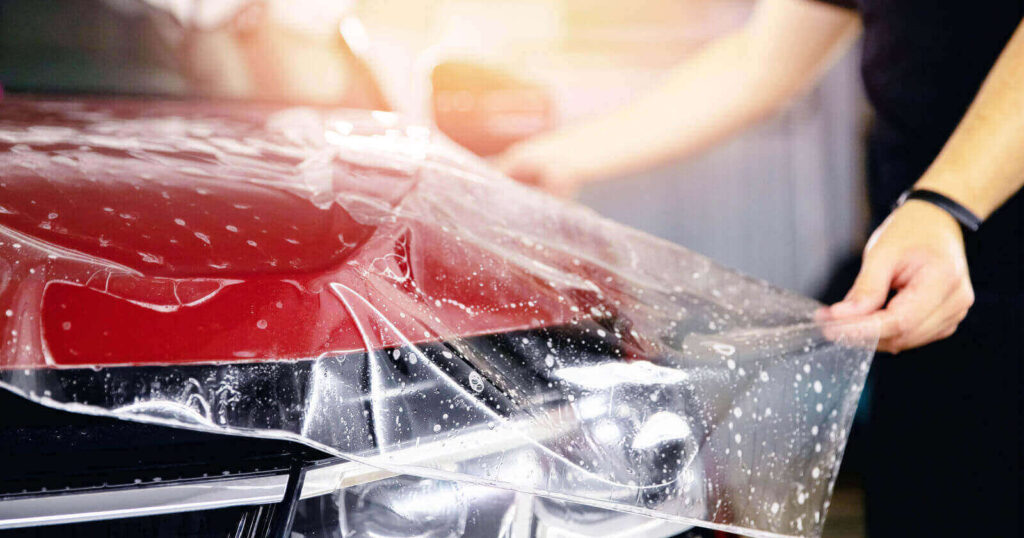Introduction
Your car’s paint is like its skin, vulnerable to scratches, UV rays and environmental hazards. Paint Protection Film (PPF) acts as a virtually invisible shield that not only preserves your car’s beauty but also boosts its longevity. Let’s break down how this advanced technology works and why it’s become a staple in the world of car care.
What Is Paint Protection Film?
Paint Protection Film, commonly known as PPF, is a transparent, durable urethane material applied to a car’s exterior surfaces to shield the paint from damage. Originally developed for military use during the Vietnam War to protect helicopter blades, PPF has since evolved into a high-tech solution for automotive care.
The Structure of Paint Protection Film
PPF isn’t just a single layer of plastic. It’s a sophisticated multi-layer system that includes:
- Topcoat Layer: Provides UV resistance and self-healing properties.
- Urethane Core: Absorbs impacts from debris and resists scratches.
- Adhesive Layer: Ensures strong bonding to the car’s surface without damaging the paint.
The Science of Protection
PPF uses advanced chemistry to deliver exceptional protection.
- Scratch Resistance: The urethane core absorbs impacts and prevents scratches from penetrating the film.
- UV Resistance: Protects your car’s paint from fading due to sun exposure.
- Hydrophobic Properties: Repels water, making it harder for dirt and grime to stick.
Self-Healing Technology in PPF
One of the most impressive features of modern PPF is its self-healing capability. When minor scratches or swirl marks appear, heat from the sun or hot water can activate the topcoat layer causing the material to “heal” itself. This ensures your car maintains a flawless finish over time.
How PPF Prevents Paint Damage
PPF acts as a buffer between your car’s paint and external threats like:
- Stone Chips and Debris: Absorbs impacts from small rocks and road debris.
- Chemical Stains: Resists damage from bird droppings, tree sap and road salt.
- Weather Elements: Shields against rain, snow and harmful pollutants.
The Installation Process
PPF installation requires precision.
- Professional Installation: Offers better results and longevity but costs more.
- DIY Installation: An option for those with experience though mistakes can compromise effectiveness.
- Steps include cleaning the surface, cutting the film to fit and using a squeegee to apply it smoothly.
Longevity and Maintenance of PPF
With proper care, PPF can last 5-10 years. Maintenance includes:
- Regular cleaning with PPF-safe products.
- Avoiding harsh chemicals and abrasive materials.
- Inspecting for signs of wear and replacing if necessary.
Advantages of Using Paint Protection Film
PPF offers a plethora of benefits:
- Aesthetic Appeal: Keeps your car looking brand-new.
- Cost Savings: Reduces the need for frequent paint touch-ups.
- Higher Resale Value: A well-protected car is more attractive to buyers.
Misconceptions About Paint Protection Film
Let’s bust some myths:
- PPF Is Only for New Cars: False. It can protect older cars too.
- PPF Damages Paint: When installed and removed properly, it’s completely safe.
- It’s Too Expensive: While upfront costs are high, the long-term savings are significant.
Conclusion
Paint Protection Film is a technological marvel that goes beyond mere aesthetics. It’s a shield, a protector and an investment in your car’s future. By understanding the science behind PPF, you can make an informed decision about safeguarding your vehicle.
FAQs
-
How long does PPF last on a car?
With proper maintenance, it can last 5-10 years. -
Can PPF be removed without damaging the paint?
Yes, when removed correctly, it leaves no residue or damage. -
Does PPF affect the car’s appearance?
No, it’s virtually invisible and enhances the gloss of your car. -
Is PPF suitable for all types of vehicles?
Absolutely. From luxury cars to daily drivers, PPF works for any vehicle. -
How do I know if PPF is properly installed?
Look for smooth application without bubbles or wrinkles.


